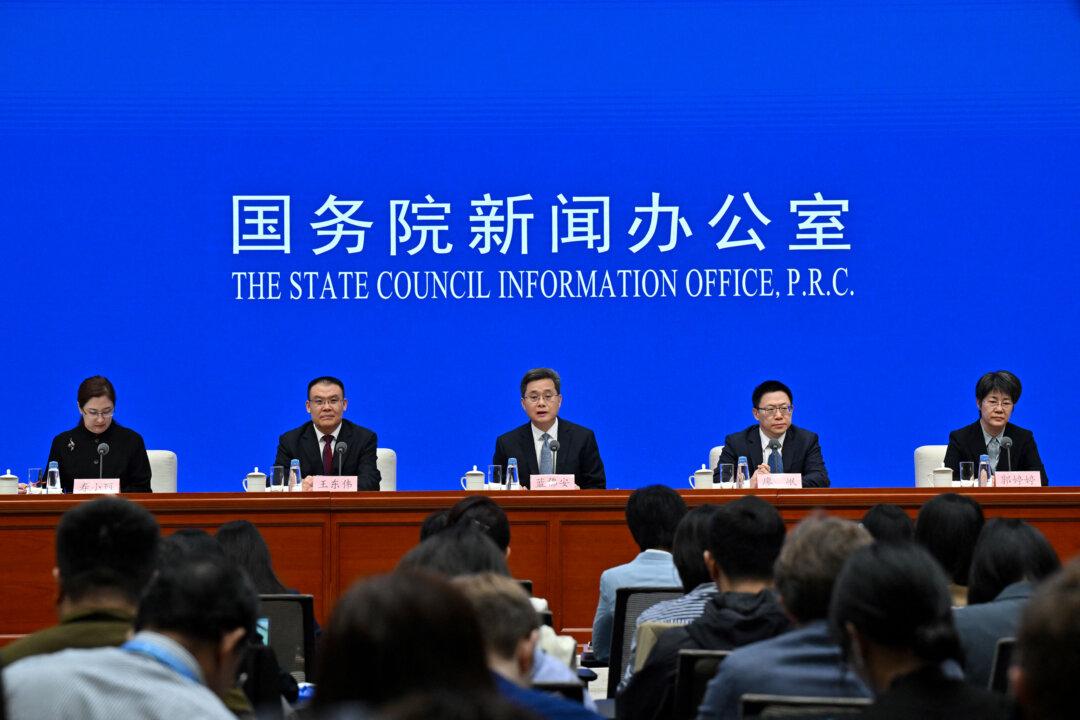However, at high-profile press conferences on Oct. 8 and Oct. 12, senior leaders discussed an upcoming fiscal stimulus extensively, but stopped short of specifying details.
As the market anticipated an accompanying fiscal policy to stimulate spending, experts pondered the necessary scale.
Prominent economists in China, including Jia Kang, dean of China Academy of New Supply-side Economics and a former Ministry of Finance official, and Liu Shijin, a former senior State Council official, told Chinese media the number would need to be 10 trillion yuan ($1.42 trillion), or about 8 percent of China’s 2023 gross domestic product (GDP).On Oct. 11, Yu Yongding, a prominent Chinese economist involved in policymaking, said Chinese institutions have floated various amounts to achieve the 5 percent growth target, ranging from 8 trillion to over 10 trillion yuan. Yu’s own estimate is over 10 trillion.
If China needs a stimulus of over 6 trillion yuan to meet the growth target, “that means they are growing zero percent this year,” he said.
Some experts have gone further. They say it’s time to view China’s economy through the lens of survival rather than growth.
“That’s meaningless, not to mention that China’s numbers are falsified.” Sun uses an alias to protect himself from retaliation from the Chinese Communist Party (CCP).
Christopher Balding, an expert at the Henry Jackson Society, a UK-based think tank, agreed that survival is an “appropriate” description of the current Chinese economy.
Stimulus or Patchwork?
The Chinese economic slump became apparent to the world when the Chinese economy failed to recover after the end of the zero-COVID lockdown policy in December 2022.Deflationary pressure persisted, although the consumer price index returned to a slight year-on-year increase in July and August. Retail sales remained sluggish. September data showed the country’s manufacturing sector contracting for a fifth month.

China has resisted rolling out a significant stimulus package. However, on Sept. 24, in what the regime called “combo punches,” China’s central bank said it was lowering the banks’ reserve requirement ratio (RRR) by 50 basis points, which would free up about 1 trillion yuan (about $142 billion) for new lending.
The People’s Bank of China (PBOC) announced that it would cut short-term borrowing rates by 20 basis points, effective Sept. 27.
Balding questions whether the policy packages are stimulus; China made similar moves last year, just not on the same day. In 2023, the PBOC reduced RRR twice and released 1 trillion yuan. In both 2023 and 2022, the PBOC cut short-term borrowing rates twice.
He added the scale was very small—2 trillion yuan is less than 2 percent of China’s GDP.
China’s decision to recapitalize commercial banks was a new move, the first time it has done so since 2008.
On Sept. 24, Li Yunze, minister of the National Financial Regulatory Administration, said China would inject core tier 1 capital—reserves banks hold to run their daily operations and cover potential losses—at six major commercial banks. Li didn’t reveal more details.
“That’s making sure that the banks don’t collapse so that the big banks can buy smaller banks on the verge of collapse. So you’re not really stimulating anything. You’re just patching it up,” said Balding.
“It’s patching up the old issues, not necessarily doing new stimulus.”

Curbing Economic Deterioration
The package announced on Sept. 24 also included reducing interest rates on existing mortgages by an average of 0.5 percent, or around 150 billion yuan (about $21 billion), to provide relief to some 50 million households. Home minimum down payments will also be lowered from 25 percent to 15 percent for second-home buyers.Nonetheless, most international banks are still watching and haven’t increased their outlook for China’s GDP growth this year.
“The current economic downturn has threatened the CCP’s political security, especially its potential to dominate Asia and change the international order,” he told The Epoch Times. “Therefore, the Party had to act.”
China’s housing market, which accounts for about a quarter of the country’s GDP, has been in a downward spiral for years.
According to the China Real Estate Industry Association, one in five homeowners in Beijing, a tier 1 market, saw the price of their home drop by over 30 percent.
Given that Chinese commercial banks lend mortgages based on 70 percent of a home’s value, they take losses when the collateral’s value drops under the loan amount.
Sun agrees. He thinks the CCP chose to boost the stock market first, because although the property market can’t be revived overnight, China’s policy-driven stock markets could instantly show an artificial bull market.

Buying Time
The surprise “combo punches” on Sept. 24 also included an 800 billion yuan (about $114 billion) package for funds, insurers, brokers, and listed companies to borrow more money to invest in the stock market by leveraging on their existing equity holdings.Immediately, the CSI 300 index—blue-chip stocks traded in Shanghai or Shenzhen—increased by over 25 percent from Sept. 24 to 30, the biggest one-week gain in nearly 20 years.
As the nation returned from a week-long vacation, anticipation was high for a policy package of a similar scale to stimulate spending.
However, investors were disappointed.
The National Development and Reform Commission (NDRC) discussed a pending stimulus package extensively at the press conference, but there were no specifics beyond frontloading 200 billion yuan from the 2025 budget.
In reaction, the Shanghai and Shenzhen stock markets dropped by about 5 percent in a single day, and Hong Kong’s Heng Seng Index fell by 8.5 percent.
The public relations blitz continued at another press conference on Saturday, Oct. 12. China’s Ministry of Finance again mentioned a pending stimulus package to “significantly” increase spending—without disclosing any details.
Xi is widely expected to continue his industrial policy of developing advanced manufacturing, which hasn’t been able to lead economic growth by compensating for the housing market’s decline.
In Sun’s view, by rescuing the property and financial markets, Xi is buying time, because digging China out of its current economic hole may take years or decades.
“When a person’s life is threatened, save it first,“ he said. ”Think about how to recover next.”







